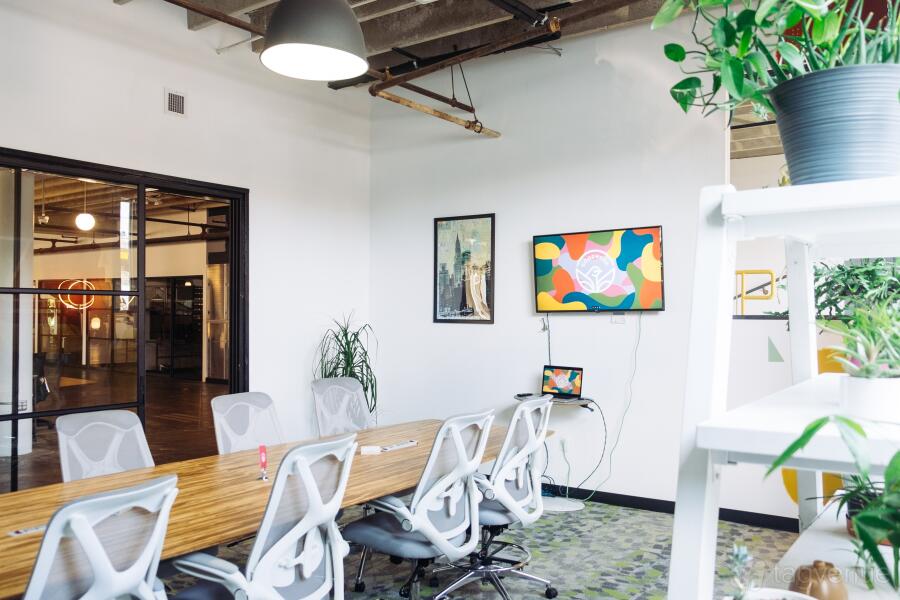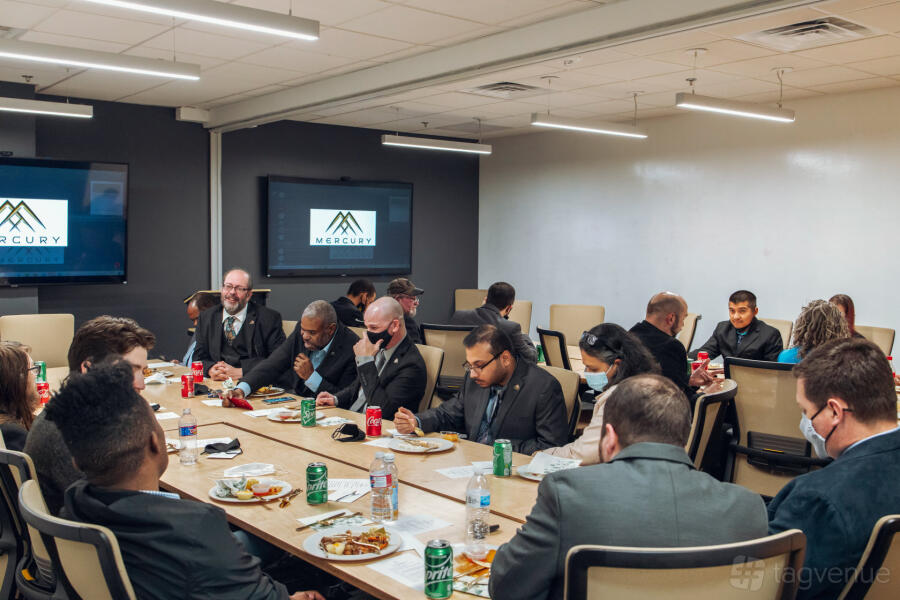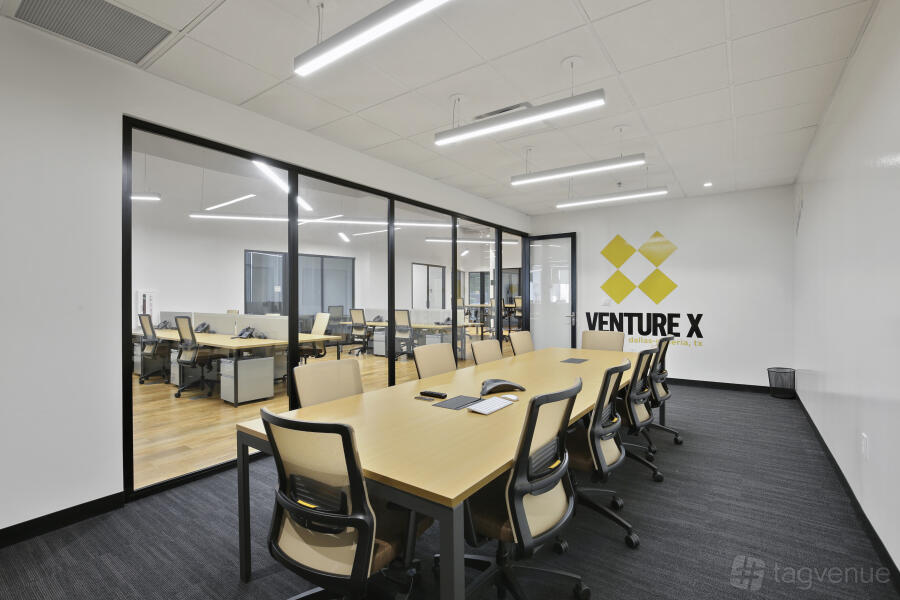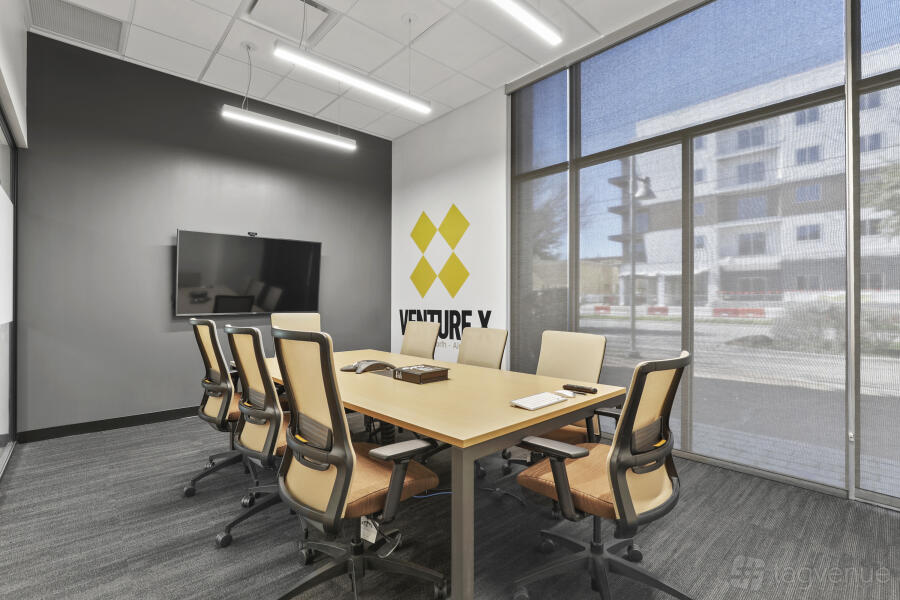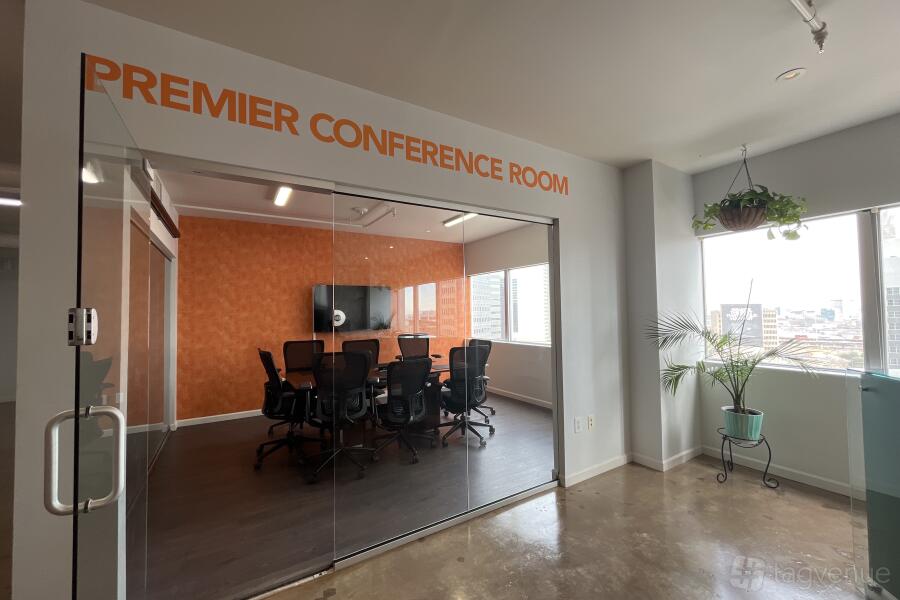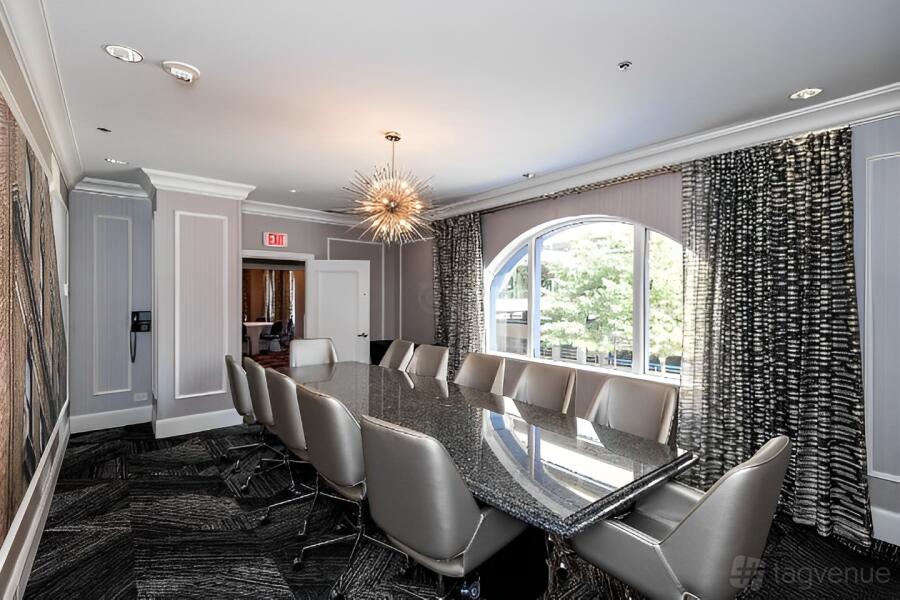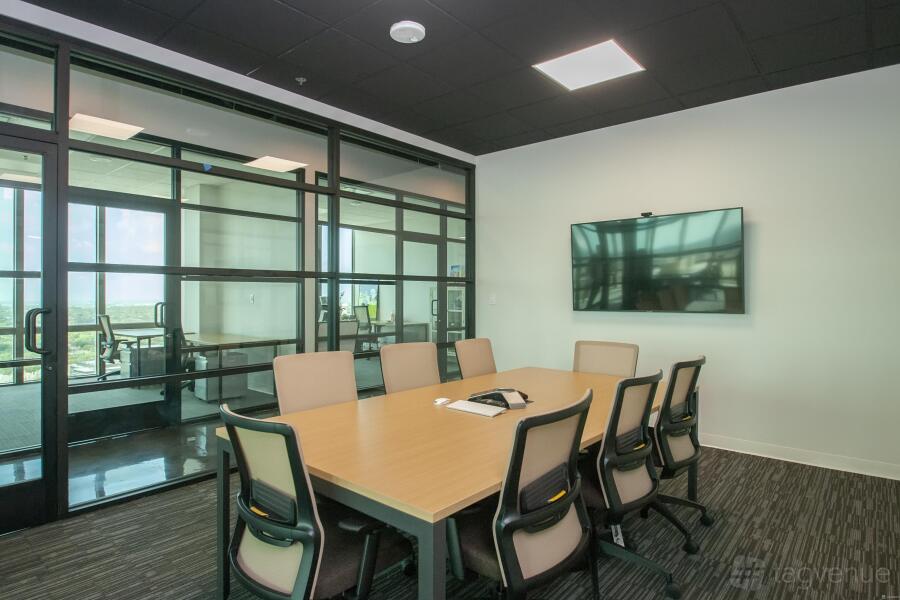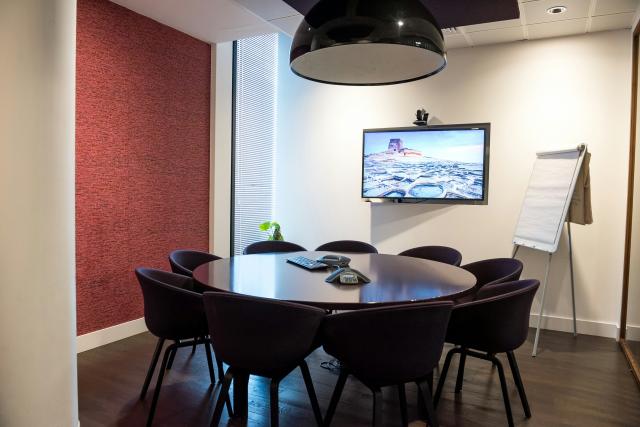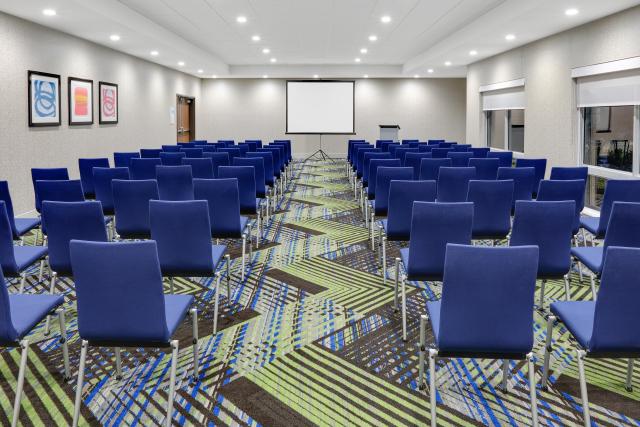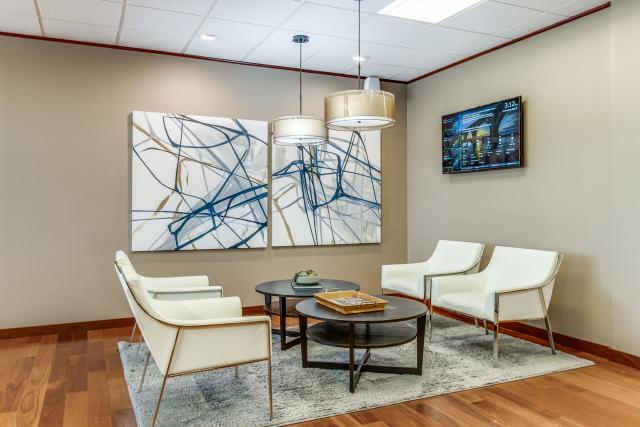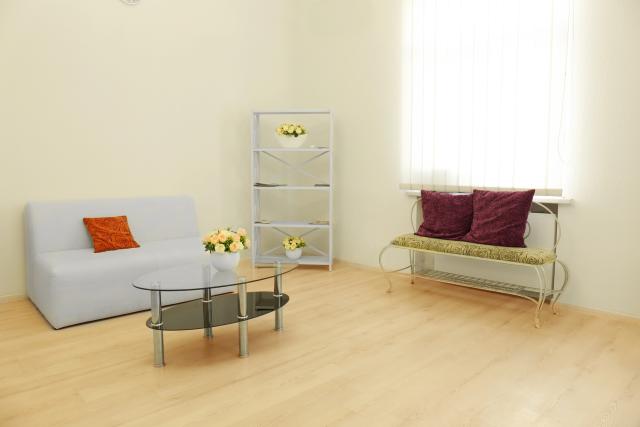Top Meeting Spaces in Dallas, TX
Looking to impress clients, onboard new talent, or host a high-impact seminar? Dallas delivers stylish, fully-equipped meeting spaces that fit every business need—from pitch-perfect boardrooms in Preston Hollow to creative studios in the Bishop Arts District. Whether you need a convention facility for your seminar with top-notch appetizers or minimalist rooms with state-of-the-art equipment for that presentation, Tagvenue makes it easy to book the ideal space, fast.
-
from $75
hire fee / per hourBook nowThe Collins Boardroom
10 guestsLucid Private Offices - Galleria Addison T1North Dallas, TXCChris L.
“Venue was great. Perfect for our meeting” -
from $60
hire fee / per hourBook nowThe Garden City Room
10 guestsGood CoworkingDallas, TXJJovita M.
“This space was so easy to book. Front staff was great and professional. A great place to meet and work.” -
from $75
hire fee / per hourBook nowLarge Conference Room
10 guestsPremier Workspaces - Two Turtle CreekOak Lawn, Dallas, TXThe Large Conference Room is designed to accommodate up to 10 people. This spacious room is perfect for meetings, brainstorming sessions, and more. With amenities like High Speed Internet, a Professional Address, an Equipped -
from $163
hire fee / per hourBook nowModern 40Person Training Room
35 guestsVenture X | Dallas by the GalleriaNorth Dallas, TXVenture X offers beautifully designed modern workspaces. You'll enjoy coworking, private offices, meeting rooms, and virtual offices with full concierge service and endless amenities. -
from $71
hire fee / per hourBook nowLarge 12Person Conference Room
12 guestsVenture X | Dallas by the GalleriaNorth Dallas, TXThis conference room is perfect for startups, corporate companies, presentations, client meetings, and interviews. -
from $60
hire fee / per hourBook nowMedium Person Conference Room
8 guestsVenture X | Dallas by the GalleriaNorth Dallas, TXThis medium 8-person conference room is fully equipped with the latest technology and amenities to make your meeting or event successful. The space includes a TV for presentations, video and phone conferencing capabilities, -
from $50
hire fee / per hourBook nowPremier Conference Room
8 guestsConnected CoworkingDowntown Dallas, TXOur Premier Conference Room is perfect for your next group or board meeting. The sleek environment features views of downtown that are sure to inspire your group's next big idea. -
from $650
hire fee / per dayBook nowMeetings
12 guestsHotel Indigo Dallas DowntownArts District, Dallas, TXOur Historic Conrad Boardroom will be perfectly suitable for the next emergency meeting with your team or a normal gathering to talk business. There is comfortable seating for each of the team members. -
from $65
hire fee / per hourBook nowThe Welch Conference Room
6 guestsLucid Private Offices - LBJ FreewayNorthwest Dallas, TXWelcome to The Welch Conference Room, a distinguished meeting space within Lucid Private Offices on LBJ Freeway. This room, located in the heart of Dallas, combines style and functionality, ideal for both creative brainstorming -
from $500
hire fee / per dayBook nowConference Room 2
10 guestsMediation and Conference FacilityDowntown Dallas, TXOur conference room offers an ideal setting for small meetings and discussions, with a boardroom capacity of up to 10 people. Designed for comfort and productivity, the space is equipped with state-of-the-art audiovisual -
from $65
hire fee / per hourBook nowThe Kroc Conference Room
8 guestsLucid Private Offices Galleria Addison T3North Dallas, TXThe Kroc Conference Room at Lucid Private Offices - Dallas Galleria Tower 3 is designed for meetings and presentations. It features comfortable chairs and a large window for natural light and a pleasant view. -
from $60
hire fee / per hourBook nowMedium Meeting Room
8 guestsFlex at The GildDallas, TXThe Medium Meeting Room at Flex at The Gild accommodates up to eight people, offering a comfortable space for mid-sized team meetings, brainstorming sessions, or client presentations.
- 1
- 2
- 3
- ...
- 5
Popular filters
Capacity
Budget
Area type
Venue type
Catering and drinks
Accessibility features

FAQs about Top Meeting Spaces in Dallas, TX
In Dallas, prices of meeting spaces average around $75 hire fee per hour. The exact costs depend on the room size, audiovisual equipment (such as projectors or microphones), or high-speed Wi-Fi. Additional services, such as catering or on-site coordinators, may cost extra. Flexible configurations for presentations, workshops, or networking, along with amenities such as parking or dedicated breakout rooms, will also affect the price. See usual price ranges in Dallas, based on Tagvenue data, as of December 2025:
| From $60 | to $85 | hire fee per hour |
| From $500 | to $750 | hire fee per day |
| From $17 | to $25 | per person |
You'll find meeting spaces in various sizes, from smaller spots to larger venues; keep in mind that the type of space and your chosen layout will affect the capacity! Below you can see the typical venue sizes in Dallas, together with the standard prices in each size range, based on Tagvenue data (December 2025):
| Small | up to 5 guests | prices average $60 hire fee per hour |
| Medium | between 10 and 10 guests | prices average $75 hire fee per hour |
| Large | over 15 guests | prices average $150 hire fee per hour |
These are the venues within 0.5 mi from central Dallas, available to book on Tagvenue:
-
Premier Conference Room at Connected Coworking
on 211 North Ervay Street - 0.1 mi from center.
Venue said: Enjoy the convenience of the wiring through the conference table to the 52 in-screen to present your ideas as well as an entire wall for whiteboard writing. -
Conference Room 2 at Mediation and Conference Facility
on 325 North Saint Paul Street STE 3900 - 0.1 mi from center.
Venue said: Its professional atmosphere is perfect for business meetings, team collaborations, and intimate workshops. The room provides a conducive environment for focused discussions, ensuring that your meetings are both effective... -
Office Space at Common Desk - Downtown Dallas
on 2001 Ross Avenue - 0.5 mi from center.
Venue said: Inside, there are black office tables, each equipped with mesh-backed chairs. The room is well-lit with bright overhead lighting, and the gray patterned rug adds a touch of elegance.
Trying to impress your guest? Book a venue in prime locations like Deep Ellum, where your guests can enjoy public parks like the Fair Park and find accommodation at the Sheraton Hotel. Remember to rent spots with the business traveler in mind-make sure that the meeting rooms are in close proximity to airports, hotels, and restaurants. Downtown Dallas has something for everyone, whether it’s the shopping or fine dining options. This place is perfect for entertaining your guests after a meeting. The Bishop Arts District is a favorite location for anyone who wants to experience the Dallasite nightlife and culture. Whether it’s the Bishops Arts Theatre Center or Kessler Theater, your guests will fall in love with their unique live shows and musical productions!
While most meeting spaces are equipped with furniture such as chairs and tables, you may also find other additional equipment on rent or for free, such as whiteboards, flip charts, projectors, and AV screens. It’s important to let the venue know in advance so that they can arrange for everything prior to the meeting.
Yes! We recommend booking at the earliest to ensure the space is available for your meeting needs. Moreover, when you book in advance, it’s easier to plan the agenda, arrange any catering or refreshments, and even customize the layout of the room according to your event requirements.
You can find different styles of meeting rooms in Dallas. Boardrooms are probably the most popular type of meeting space with a large oval or rectangular table that you find typically see in many sitcoms and movies. They are mostly used for discussing important matters. These can accommodate around 25 people. If you’re hosting a talk or an award ceremony, choose a banquet-style meeting room where you can easily connect with other people-great for some networking. If you’re meeting with a bunch of creatives to discuss some new project and wish to keep it low-key, you can rent a co-working space or creative room for your meeting. It’s affordable and less formal than the other types of meeting rooms. Among other meeting spaces in Dallas, you’ll find small or large conference rooms, functional rooms, classroom-style meeting rooms, and more relaxed meeting spaces with couches or no chairs (perfect for brainstorming sessions). Most of these spaces offer state-of-the-art technology, high-speed internet, and on-site support teams. Just make sure to confirm everything with the venue manager before making a reservation!
Your Guide to Renting Meeting Spaces in Dallas, TX
Why Book a Meeting Space in Dallas?
In today’s hybrid work world, your meeting venue speaks volumes. Dallas has you covered with:
- Modern, AV-equipped meeting rooms for presentations and strategy sessions
- Flexible creative spaces for workshops and brainstorms
- High-capacity conference venues for seminars and training days
- Elegant corporate venues near top hotels like The Ritz or Rosewood Mansion
Best Meeting Spaces In Dallas
If you’re after the best meeting spaces in Dallas, you’ll find them right here—no spreadsheets or stress required. From polished boardrooms near the Galleria to eco-friendly coworking spots in the Cedars, we’ve rounded up the smartest spaces for every type of meeting.
- Good Coworking – Cedars, Dallas
Creative vibes meet sustainability at this sunny coworking hub near Southside Ballroom. Their 10-person meeting room is $60/hour—ideal for collaborative planning sessions or eco-conscious entrepreneurs needing privacy with flair. - Hilton Garden Inn – Northeast Dallas
Need room to move? This spacious meeting venue seats 45 and can hold 50 standing, all for a flat $550/day. Great for workshops, training days, or bringing the whole department together.
Are There Dallas Meeting Rooms That Can Be Rented By The Hour?
Dallas has plenty of meeting rooms available by the hour, and Tagvenue makes it super easy to book them. If you just need a spot for a quick client call, a brainstorming session, or a last-minute team huddle, there are flexible spaces all over the city that won’t lock you into a full-day rate.
- Common Desk – West End (Downtown Dallas)
Located in the historic West End, this 12-person meeting space offers a creative, well-designed setting for client calls, team planning, or small presentations. At $100 per hour, it’s a solid pick for teams that want a central location with great amenities and walkable lunch spots nearby. - Executive Workspace – Uptown Dallas (Oak Lawn)
This 8-seat meeting room is ideal for polished, professional gatherings without the big price tag. For $55 per hour, you’ll get a quiet, comfortable space just minutes from the action in Uptown—perfect for impressing clients or getting things done without distractions. - Venture X – Dallas by the Galleria (North Dallas)
Need a modern space near one of Dallas’s biggest commercial hubs? This 12-person meeting room is available at $71 per hour and sits right by the Galleria. Ideal for fast-paced strategy sessions, team check-ins, or when you need something stylish and efficient.
What to Look for in a Dallas Meeting Space
Capacity & Layout
- Small meetings (2–10 people): Boardrooms in Uptown, Lake Highlands, or Victory Park
- Medium-size groups (10–40): Creative rooms with breakout spaces and whiteboards
- Large-scale events (50–200+): Conference halls or banquet-style setups near Downtown or the Design District
Tech Essentials
- High-speed Wi-Fi
- LCD screens or projectors
- Whiteboards, flip charts, and conferencing tools
- Charging stations at every seat
Flexibility
- Adjustable seating for workshops or panels
- BYO equipment or hybrid meeting support
- Early access or overtime extensions
Amenities
- Parking or valet options (especially important outside city center)
- On-site or partner catering
- Reception desk or staff support
- Nearby dining and hotel access for visiting guests
Popular Business-Friendly Neighborhoods in Dallas
- Downtown Dallas – Prime real estate for major presentations and conferences
- Uptown – Upscale, walkable, and packed with dining options for post-meeting catch-ups
- Bishop Arts District – Ideal for creative sessions or relaxed client conversations
- Preston Hollow – A favorite for private, high-profile meetings
- Deep Ellum – Edgy and energetic, perfect for startups and innovation teams
How to Run a Great Meeting
- Start with a Goal
Define the purpose before booking. Whether you're solving a problem, delivering updates, or pitching an idea, clarity helps you structure the space and agenda. - Send the Agenda Early
Let guests know what to expect. Bonus: Include a calendar invite with the venue address and parking info. - Keep It Structured—but Not Rigid
Stick to your time slots, but allow space for questions or discussion. A meeting that flows feels effortless—because it’s well-prepared. - Don’t Skip the Amenities
Offer water, coffee, or better yet—light catering. Small touches make a big difference in guest comfort and energy levels. - End With a Clear Summary
Wrap up with action items and a quick recap. If needed, send a follow-up email outlining key points and next steps. - Add a Post-Meeting Experience
Want to make your event stand out? Treat guests to something extra:
- A team lunch or dinner at a nearby restaurant
- Drinks on a rooftop patio in Victory Park
- A guided walk or quick tour through Klyde Warren Park or the Dallas Arts District
- Corporate gifting with local flair (think curated snack boxes or artisan coffee kits)
Your next successful meeting starts here—browse and book your Dallas venue today.
People also search for
Meeting Spaces in Texas
Meeting Spaces in other cities
Verified Reviews of Meeting Spaces in Dallas, TX
Page last updated in December 2025
To provide you with relevant information, our pages are refreshed using an algorithm that aggregates real-time data, including bookings, reviews, and venue updates.

